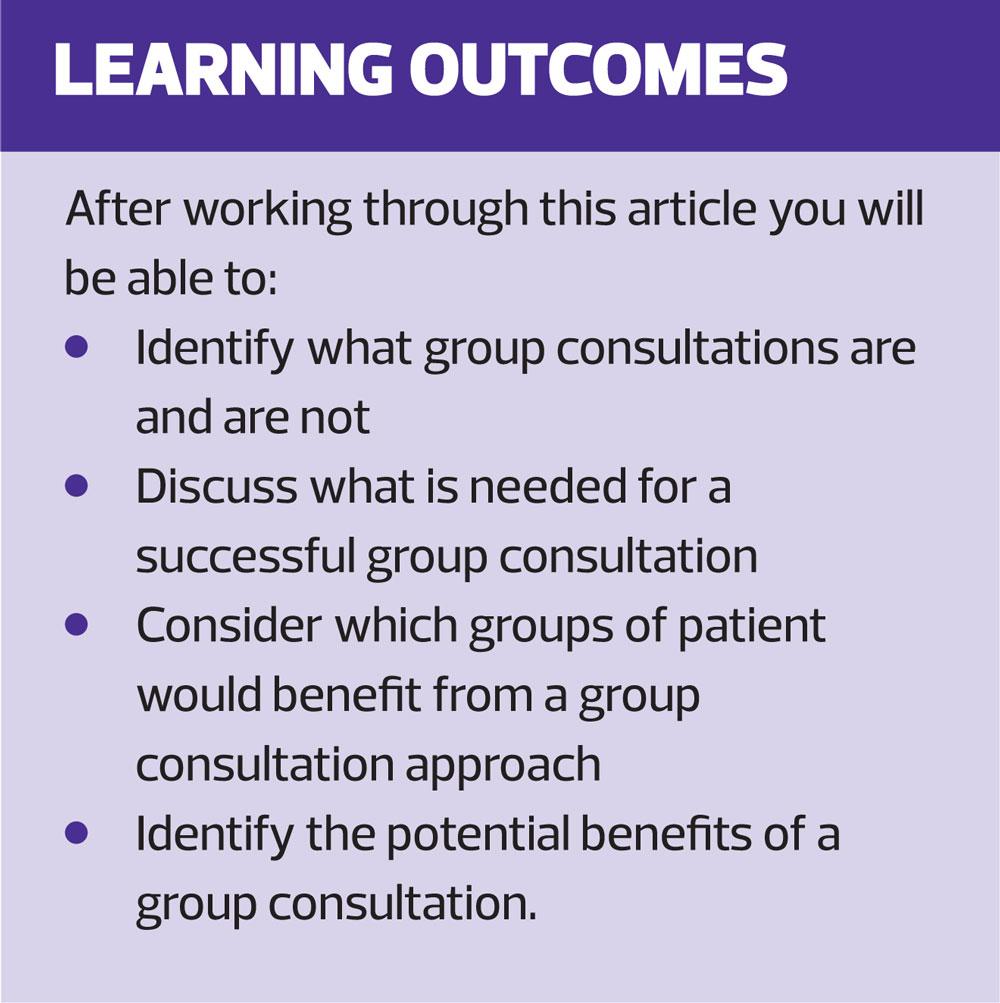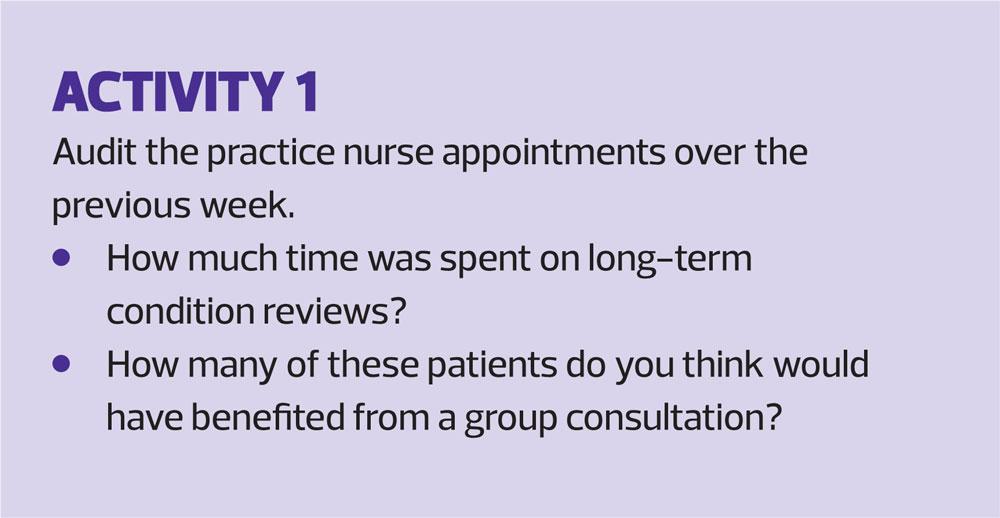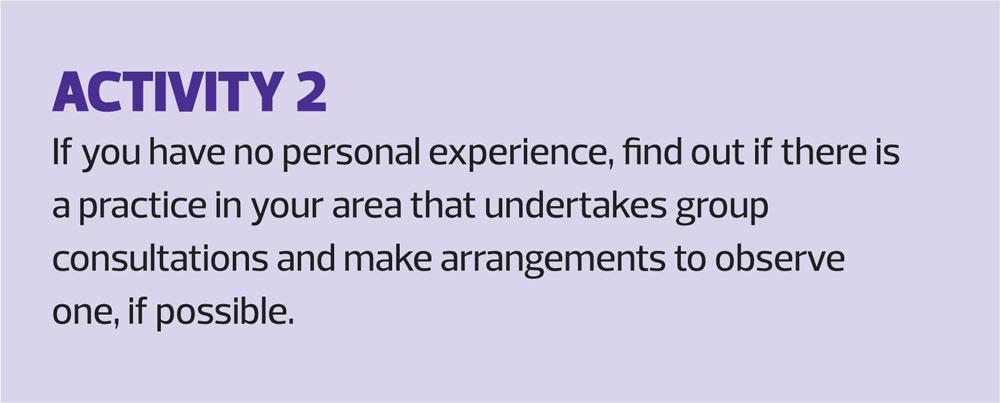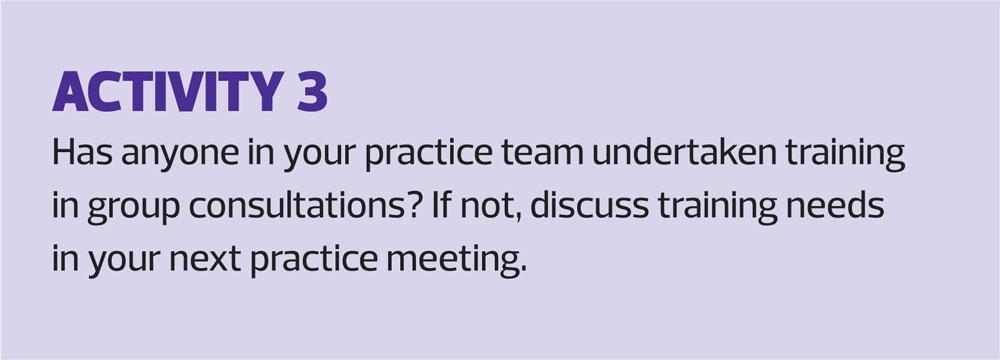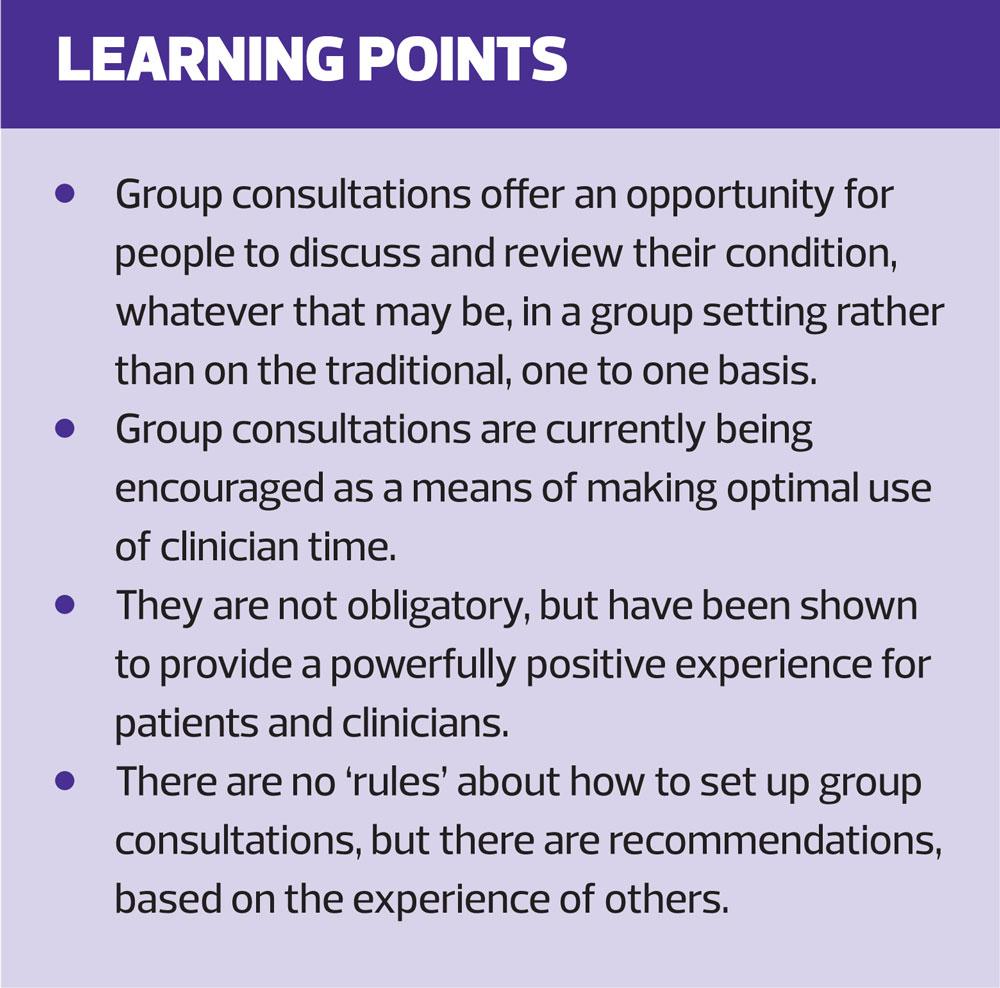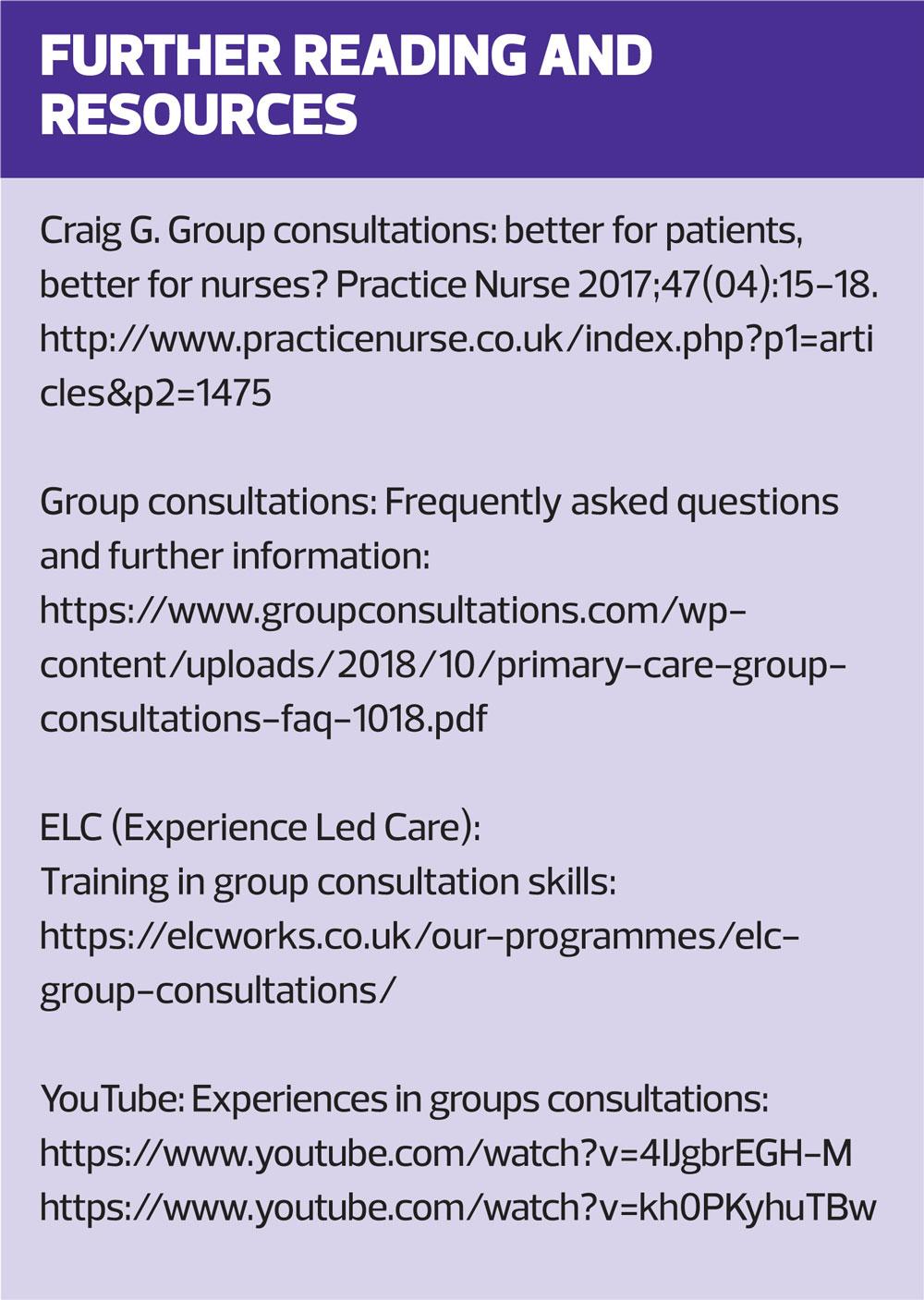Group consultations: the why and the how
BEVERLEY BOSTOCK-COX
BEVERLEY BOSTOCK-COX
RGN MSc MA QN
Nurse Practitioner Mann Cottage Surgery, Moreton in Marsh
Education Lead, Education for Health, Warwick
LOUISE BRADY
RN BSc hons
Practice Nurse, Nurse Lead Primary & Community Care, Greater Manchester Health & Social Care Partnership, North West Clinical Lead Group Consultations
EMMA K HODGSON
RN
Practice Nurse, Lancaster Medical Practice, Quality Ambassador, Freedom to Speak Up Guardian
Group consultations are being encouraged by government and have recently made news headlines, but confusion remains about what they are, whether they are a good or bad thing, and how they work in practice
Group consultations, also known as shared medical appointments, are an alternative to the traditional one to one appointments. They are, instead, delivered by a general practitioner (GP), nurse or pharmacist, in partnership with a group of patients with similar health issues, in a supportive group setting. This approach is something the Government is encouraging clinicians to consider,1 and the feedback from patients who have attended group consultations (admittedly a self-selecting group) has been overwhelmingly positive.2
This article aims to clarify what a group consultation is, and is not. As well as discussing how they work and who should attend, it will consider their place in primary care and share some personal experiences of setting up CGs in practice.
WHAT IS A GROUP CONSULTATION?
The idea of group consultations is that they offer an opportunity for people to discuss and review their condition, whatever that may be, in a group setting rather than on the traditional, one to one basis. All attendees can share each other’s experience and listen to other peoples’ questions and the subsequent recommendations that would normally only be shared between one clinician and one patient.
Group consultations enable people with the same condition to share their own, personal experiences of that condition (not something most healthcare professionals can do), to recognise the fact that they are not alone, and to support each other to deal with the condition through effective self-management. Group consultations can create an environment suitable for unrestricted dialogue and exchange beyond the ‘one clinician, one patient’ scenario, and can bring about insights and health outcomes that those individuals might not reach on their own.
Group consultations can replace standard consultations, such as an annual review. They are not extra to them, so they do not add to the workload but should, in fact, help to streamline it. In group consultations the clinician can potentially see 10 or more patients in a 60-minute slot. Working this way can significantly impact on clinician capacity, whilst giving patients more time to discuss their feelings and concerns, thus creating the time and space for both patient and clinician to thrive.
It is important to remember that they are not obligatory to either party but that they have been shown to provide a powerfully positive experience for patients and clinicians.
WHAT A GROUP CONSULATION IS NOT
People sometimes liken group consultations to joint education groups, like DESMOND or DAFNE (for type 2 and type 1 diabetes respectively) or pulmonary rehabilitation groups, but this is not the case. Although group consultations may offer the opportunity for joint learning and can offer support to people with the same condition, the key difference is that they are patient-led. There is no clinician-led agenda, with items that need to be covered being ‘ticked off’. Instead, patients are encouraged to bring along questions or issues that they would like to discuss, much as they might do in a one-to-one consultation, but to share these with the others in their group. Group consultations are therefore not clinician-led education sessions (although they can sometimes cover this too), and they are not designed only to address what’s included on a Quality Outcomes Framework (QOF) template. Instead it is the patients who decide what is discussed and where the conversation takes them. Ultimately, group consultations are what you make them because (as yet) there are no ‘rules’!
RATIONALE
Evidence suggests that the current model of short consultations for long term conditions may not be working effectively, either for clinicians or for the population we serve.3
People say that they are not given adequate time for important conversations and that they want to spend longer with trusted clinicians. They also value continuity of care when attending for review of their long-term conditions.
For clinicians, time constraints within general practice can be a real challenge, with some nurses being given just 10 minutes to carry out a review. Even those who have more time (20-30 minutes) can find it hard to cover the needs of the patient and ‘the system’ (often QOF) in this time. As a result, both professional and personal wellbeing can be negatively affected. This in turn can impact on the patient experience because clinicians who are burnt out have been shown to interact less effectively with patients.4
Group consultations are one of the ‘new consultation types’ named in the 10 High Impact Changes in the GP Forward View.5 They are recognised as ‘a promising response to escalating demand for healthcare’,6 and there is a strong evidence base for them. Studies demonstrate that they enhance patient experience, improve clinical outcomes and reduce hospital admissions and A&E attendance.7
Independent evaluation of group consultations in general practice in Sandwell, Birmingham showed that the group model contributed significantly to the delivery of quantifiable savings, and freed up practice and GP capacity. The evaluation found that 69% of participants improved their body mass index (average reduction from 35.4 to 34kg/m2) and 84% had an improved blood pressure control at 12 months compared to baseline. Participants fed-back that group consultations added value and reported improved confidence in their ability to self-care.8
HOW TO SET UP A GROUP CONSULTATION
There are no ‘rules’ about how to set up group consultations, but there are recommendations based on the experience of others. Recommendation number one when setting up your first group consultation is don’t overthink or over-plan it. These consultations will work differently for different individuals (clinicians and patients) so it is important at the start to choose a way that will work best for you – and perhaps focus on a clinical area that you have a strong interest in.
You will need a suitable room, with the necessary equipment and space, and you will need staff to deal with the administrative side. It is also recommended that you think about the facilitator role and how that complements your own input as the clinician.
The administrator can offer support with tasks such as sending out invitations to patients, collating lists of attendees and organising blood and other test results. A suitable facilitator may be selected based on their enthusiasm, training, experience and skills.
Before the session all results should be in place e.g. blood tests, blood pressure etc. and written onto a board for all to see and compare, as these will be shared and openly discussed during the session.
Most importantly, you need people to come along! You should consider who might get the most from a group consultation. These are often people who might enjoy a longer consultation, or hearing from others who have the same condition and who are happy to share their experiences. These people might include those who appear to overuse, underuse or inappropriately use healthcare resources, or people who are struggling with their symptoms or treatment.
You then need to think about which clinical area you would like to cover. As previously mentioned, start off with an area that you would like to cover, as this gives you the easiest start to this new way of working. There may well be clinical areas in your practice where there is a greater need than others, but when you are starting out, keep it simple and fun. That word ‘fun’ is a big feature of group consultations.
Invitations can then be sent, explaining the nature and purpose of the consultation and also indicating that the focus is on sharing information (such as blood results) and experiences as this has been shown to be a very effective intervention. People can also be advised in the letter about the importance of maintaining confidentiality. Invitation letters should explain how the session will work, and how long it should last and can also include information about whether partners or adult children can attend as support. This is potentially a really good idea but you should consider how much space you have.
The idea of a group consultation is to carry out one to one consultations within a group setting, so that everyone gets to discuss their particular concerns while others in the group share those concerns, and share ideas and information about them too. So, you may need to think about how you might break the ice – for example, by starting the session with a coffee and giving people time to chat for a few minutes. It’s also useful that all those attending are in the same boat, as they immediately have something in common. A few posters in the room might give people something to think about.
Think about what resources you might like to have available – anatomical models, inhalers, leaflets, for example – and make sure you have enough. Consider putting together information on local resources – support groups, counselling services or social prescribing interventions, for example. Then you are all set to go.
WHAT HAPPENS IN A GROUP CONSULTATION
In the session itself, the group gets together, bringing questions or issues they would like to raise. The facilitator collates these questions, perhaps by getting people to jot them down on paper, and potentially sorting them into themes. After this time, the clinician may join the group to carry out one to one discussions. In many cases, the same issues will be of concern to different members in the group so a shared approach to the issue will be used, involving clinicians and patients.
Confidentiality
The group consultation is a computer-free zone. Data such as blood results and blood pressure or lung function and disease impact scores must be collated beforehand so that people can see, discuss and compare their results. This concept of sharing and comparing personal information is the issue that many healthcare professionals (HCPs) may have concerns about, with respect to confidentiality, but it is important to remember that the general public are not bound by the same rules about confidentiality as HCPs, and many conversations that take place in the waiting room between patients are far more open and explicit than any HCP might consider to be appropriate. It is obviously essential, however, that people are aware that their information will be shared with others and that they realise that by attending, they are giving permission for this to occur. All attendees should be asked to respect each other’s privacy. Beyond this, the HCP has no control.
Facilitators
It has been said that one of the big mistakes that people carrying out group consultations make is not to have a facilitator. This individual not only helps with the initial part of the consultation, but also helps with time keeping, allowing the clinician to move on in a timely fashion. At the end of the session, and after the clinician has left, the facilitator can tie up any loose ends and carry out an evaluation of what went well, or less well, ready for the next time.
However, each practice will need to decide on the best way it will work for them. If the clinician is an experienced facilitator, they may feel that the session flows better with just one person running it.
PERSONAL EXPERIENCES
Emma Hodgson: Group consultations in cancer care as a long-term condition
Statistics from Macmillan show that, with advances in treatment, more people are living with and beyond cancer and may have ongoing needs and concerns, including physical, mental, lifestyle and information needs.9 They may not, however, receive systematic follow up in primary care in the current system.
As part of QOF, cancer care reviews are financially rewarded within the 6 months following a cancer diagnosis.10 After this one-off review no further review is needed to comply with QOF. This means those living with and beyond cancer in the community may only receive follow up to address any ongoing issues and concerns through self-initiated appointments with their GP, nurse practitioner or practice nurse. Some individuals may still also have access to cancer nurse specialists for follow up, but this does not apply to all.
There is evidence that a holistic needs assessment at regular intervals, a process that elicits needs and educates individuals to ensure that they are able to make informed choices about their health and wellbeing, improves care outcomes.9 Motivating people to make healthy lifestyle choices can reduce both the chances of a recurrence of their cancer, and the risk of their developing other long-term conditions. Such an approach has the potential to improve overall population health, which in turn produces both individual and societal gains.
At my large general practice in Lancashire, following an opportunity for training in group consultation, an innovative approach to the ongoing needs of cancer survivors is being addressed through the development of the role of the general practice nurse (GPN). Many GPNs are expert in the management of long-term conditions,9 an umbrella term that encompasses holistic care as well as chronic disease management, so the further development of the role, to include GCs for cancer care reviews, fits well.
A practice-based computer search generated a patient list that the team checked to ensure patients were suitable for a group consultation. The GPN telephoned patients to invite them, information packs were sent out and patients were given a telephone reminder. Six patients were followed up in two group consultations over 6 months. The Macmillan Cancer Support Holistic Needs Assessment (HNA),11 was used as a framework, allowing the team to elicit and respond to patients' concerns, and to quantify the impact of the group consultation on those concerns.
The group consultation saved 30 minutes of clinician time compared with carrying out six 1:1 reviews. Usually the GP does the cancer review, but this approach used the expertise of the GPN, making it time-efficient while ensuring patients’ needs were still addressed.
Minimal preparation for the group consultation was needed as few biometrics are tracked in cancer reviews, again ensuring valuable time in general practice was used wisely.
The effect of this approach on well-being was tracked through the data collected with the HNA concerns checklist. At baseline, 66% of patients had at least one area of concern. On average, those patients reported 8.3 specific concerns:
- 4 physical
- 2.5 emotional
- 1.8 lifestyle and information.
At follow up, 66% no longer had concerns. The 33% who still had concerns had an average of:
- 4 physical
- 1 lifestyle
- 1 information
- 2 emotional.
The total number of concerns at baseline was 33. At follow up, it had reduced to 14, a reduction of 58%. The average, self-assessed 'overall level of concern' was 3 at baseline and 2.2 at follow up, a reduction of 36%.
Patients were also asked about their thoughts and feelings about the experience of being part of a group consultation. They felt the group approach worked well for on-going follow up and assessment. However, this approach might also have worked for their initial primary care review following diagnosis, the component mandated in the QOF Framework that was historically carried out by GPs.
Patients were happy to talk within the group and felt that they learned from each other. As a GPN, I found working in a group consultation an enjoyable experience that feels holistic, person centred, motivating and rewarding. We are planning to combine cancer review with reviews for concomitant long term conditions such as hypertension.
Beverley Bostock-Cox: Group consultation in pre-diabetes
Group consultations can work well in diabetes care, pre-diabetes and chronic obstructive pulmonary disease. In the case of group consultations for people with pre-diabetes, personal experience has shown an extremely high level of patient satisfaction and interaction, and significant increases in effective use of clinician time.
In terms of clinical benefits, a review of the impact of these consultations has demonstrated weight loss in the majority of patients. One individual lost over 30 kilos in a year, a fact that he attributed directly to his two attendances at group consultations. Furthermore, among the group:
- No patient experienced deterioration of their HbA1c, despite this being the natural course of events;
- Two patients’ HbA1cs remained the same (42mmol/mol), and
- All of the others showed an improvement.
- Over 50% now have an HbA1c in the normal range (i.e. not pre-diabetic).
- All of the others were still pre-diabetic but with an improved HbA1c.
Patients were very enthusiastic about how the group consultation setting specifically had inspired them to change.
SUMMARY
Group consultations have been shown to have a positive impact on both the patient and clinician experience of care. Clinicians can see more than 10 patients in an hour, patients get much more time to discuss their condition, with input from others who have the same condition, issues and concerns. A great advantage is that with good facilitation skills, timings aren’t an issue as no-one runs late. Overall group consultations can have a positive impact beyond the clinical benefits, particularly with respect to the psychosocial elements of living with a long term condition.
REFERENCES
1. Ramdas K, Darzi A. Adopting innovations in care delivery – the case of shared medical appointments. New England Journal of Medicine 2017; 376(12): 1105-7
2. Birrell F, Brady L, Jones T. Group consultations, benefits and implementation strategies. Practice Nursing 2018; 29(10): https://doi.org/10.12968/pnur.2018.29.10.484
3. Fischer M, Ereaut G. When doctors and patients talk: making sense of the consultation. London: The Health Foundation, 2012
4. Maben J, Peccei R, Adams M, et al (2012). Patients experience of care and the influence of staff motivation, affect and wellbeing. National Institute for Health Research Service Delivery and Organisation Programme, 2012. http://www.netscc.ac.uk/hsdr/files/project/SDO_ES_08-1819-213_V01.pdf
5. Royal College of General Practitioners. Spotlight on the 10 high impact actions, 2018
6. Hayhoe B, Verma A, Kumar S. Shared medical appointments A promising response to escalating demand for healthcare. British Medical Journal 2017; 358: 4034 https://doi.org/10.1136/bmj.j4034
7. Edelman D, McDuffie JR, Oddone E, et al. Shared medical appointments for chronic medical conditions: a systematic review. Veterans Affairs Evidence Synthesis Project #09-010; 2012. http://www.ncbi.nlm.nih.gov/books/NBK99785/
8. Pathfinder Healthcare Developments (Community interest company) Redesigning primary care: outcomes in Smethwick, 2011.
9. Macmillan Cancer Support. Improving cancer services through primary care commissioning: top tips for care commissioning. 2016 https://www.macmillan.org.uk/documents/aboutus/health_professionals/primarycare/toptipsforcomissionersimprovingcancerservices.pdf
10. NHS digital. Quality and Outcomes Framework (QOF). 2018 Available online at: https://digital.nhs.uk/data-and-information/data-tools-and-services/data-services/general-practice-data-hub/quality-outcomes-framework-qof
11. Macmillan Cancer Support. Holistic needs assessment: care and support package. http://be.macmillan.org.uk/Downloads/CancerInformation/ResourcesForHSCP/InformationResources/MAC16266HNAHowtoguide2016A4DIGITALAW.pdf
